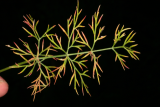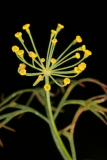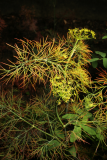An extract made by boiling the berries of the bay tree and flowers of dill marinated in olive oil could be rubbed on to ‘lessen weariness’. Dioscorides’ Materia Medica (circa 80 CE)
DeSwiet, Michael. (2012). Plants and the Olympic Games.
link
Culpeper: ‘Anethum. Dill ... Dioscorides says it breeds milk in nurses, but Galen he denies it, however it stays vomiting, easeth hiccoughs, assuages swellings, provokes urine, helps such as are troubled with the fits of the mother, and digest raw humours.’ ‘Dill seed ... dulls the sight and is an enemy to generation.’
Culpeper, Nicholas. (1650). A Physical Directory . London, Peter Cole.
For flatulent colic (1836)
Stephenson, J. & Chrchill, JM (1836) Medical Botany . London, John Churchill
Medicinal uses
Uses supported by clinical data
None.
Uses described in pharmacopoeias and well established documents
Treatment of dyspepsia (25), gastritis and fl atulence (1, 26), and stomach
ache (27).
Uses described in traditional medicine
As an aphrodisiac, analgesic, antipyretic, diuretic, emmenagogue, galactagogue,
appetite stimulant and vaginal contraceptive. Treatment of diarrhoea,
asthma, neuralgia, dysuria, dysmenorrhoea, gallbladder disease,
insomnia, hiatus hernia and kidney stones (9, 26–29).
Contraindications
Traditionally, extracts of fruits (seeds) have been used as a contraceptive
and to induce labour (4). Furthermore, extracts of the fruits may have
teratogenic effects (39). Therefore, the use of Fructus Anethi during pregnancy
and nursing is not recommended.
WHO Monographs on Selected Medicinal Plants. Vol. 3, 2007



